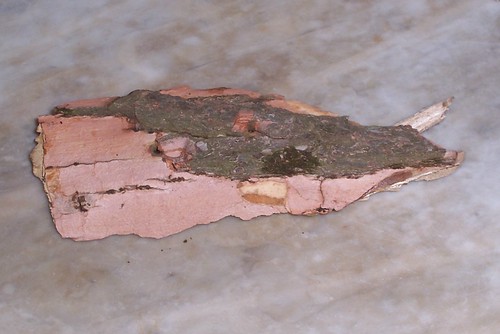After yesterday's splenetic purge I'm feeling much better now, thank you.
We really did have a nice weekend. I got quite a bit of good housework done Saturday, was able to be lazy Sunday, and was even able to potter about the garden a bit on Monday.
It was not a perfect job at everything, other than the lazing about on Sunday (a thing at which I am extraordinarily good). I still need to mop the bathroom floor, for example. But it was pretty good.
Garden pottering was limited to pruning the rosebushes and pulling leaves out of the pond (again) because it's still only February. While doing that I noticed that the sassafras tree in the corner of the yard was quite literally about to fall down.
Here's a chunk of the affected area, near the base of the trunk. Something chewed it from the inside out -- see the emergence holes?

It was not a very large tree, and the Viking has some experience in treeherding. We managed to get it down, by ourselves, with no damage to ourselves or our house, and before it fell on the neighbour's car (or the neighbour).
Also we managed to get it down without stomping the hellebores (just now starting to bloom), the azaleas, or the sweet box I put in last year too badly. The Viking understands something about treeherding, but he has a bad habit of putting his feet exactly in the middle of ornamental plants, even when there is no reason to do so.
Since I have something of a professional interest in treemunching insects, I have been trying to figure out what ate my tree. The Forest Service silvics manual lists two wood-boring insects that attack sassafras, the sassafras borer (Oberea ruficollis [Fabricius]) and a wood-boring weevil (Apteromechus ferratus). The damage on my tree isn't consistent with the sassafras borer, but I can't find anything else about the weevil other than it's one of the family Curculionidae (snout weevils), along with about 7,000 other species. That doesn't really tell me much.
There is also a non-native ambrosia beetle (Xyleborus glabratus), which is known to attack sassafras and redbay trees, and spread the fungus which causes Laurel Wilt Disease. However the damage isn't consistent with what I understand of Laurel Wilt damage, and my other sassafras trees are OK (I went looking for similar damage and didn't see it), so I don't think I need to call the state department of agriculture in a panic just yet.
The good news is nothing else in the yard seems to have been chomped, it doesn't seem to be the work of a quarantine pest, and starting about a foot above the section which was damaged and rotted, the tree was sound enough. The Viking is going to cut it down to size to use in his smoker.
We really did have a nice weekend. I got quite a bit of good housework done Saturday, was able to be lazy Sunday, and was even able to potter about the garden a bit on Monday.
It was not a perfect job at everything, other than the lazing about on Sunday (a thing at which I am extraordinarily good). I still need to mop the bathroom floor, for example. But it was pretty good.
Garden pottering was limited to pruning the rosebushes and pulling leaves out of the pond (again) because it's still only February. While doing that I noticed that the sassafras tree in the corner of the yard was quite literally about to fall down.
Here's a chunk of the affected area, near the base of the trunk. Something chewed it from the inside out -- see the emergence holes?

It was not a very large tree, and the Viking has some experience in treeherding. We managed to get it down, by ourselves, with no damage to ourselves or our house, and before it fell on the neighbour's car (or the neighbour).
Also we managed to get it down without stomping the hellebores (just now starting to bloom), the azaleas, or the sweet box I put in last year too badly. The Viking understands something about treeherding, but he has a bad habit of putting his feet exactly in the middle of ornamental plants, even when there is no reason to do so.
Since I have something of a professional interest in treemunching insects, I have been trying to figure out what ate my tree. The Forest Service silvics manual lists two wood-boring insects that attack sassafras, the sassafras borer (Oberea ruficollis [Fabricius]) and a wood-boring weevil (Apteromechus ferratus). The damage on my tree isn't consistent with the sassafras borer, but I can't find anything else about the weevil other than it's one of the family Curculionidae (snout weevils), along with about 7,000 other species. That doesn't really tell me much.
There is also a non-native ambrosia beetle (Xyleborus glabratus), which is known to attack sassafras and redbay trees, and spread the fungus which causes Laurel Wilt Disease. However the damage isn't consistent with what I understand of Laurel Wilt damage, and my other sassafras trees are OK (I went looking for similar damage and didn't see it), so I don't think I need to call the state department of agriculture in a panic just yet.
The good news is nothing else in the yard seems to have been chomped, it doesn't seem to be the work of a quarantine pest, and starting about a foot above the section which was damaged and rotted, the tree was sound enough. The Viking is going to cut it down to size to use in his smoker.

No comments:
Post a Comment